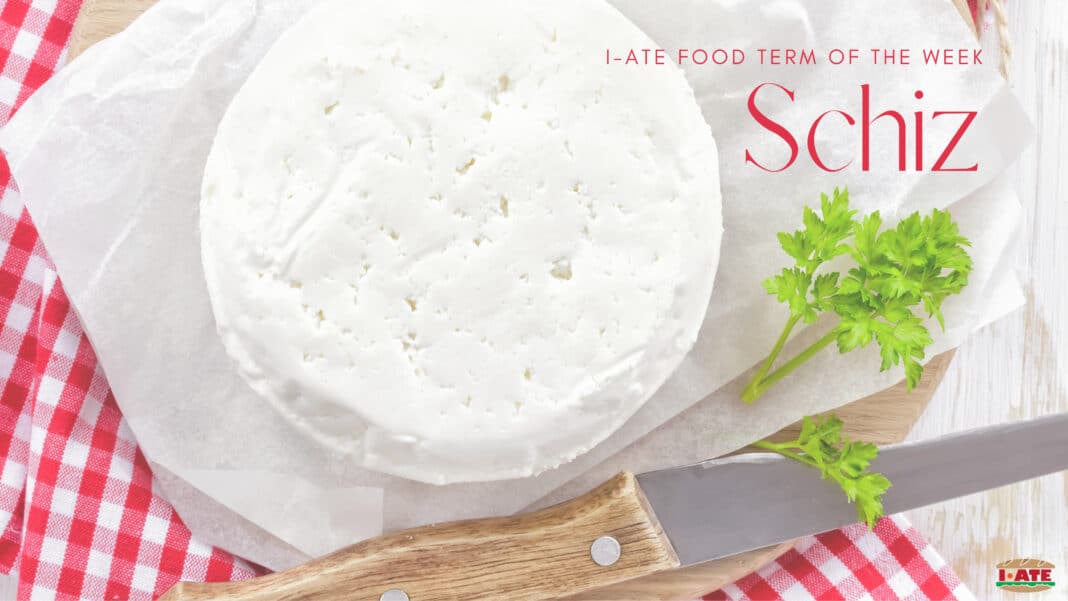Schiz is a typical cheese from the Italian province of Belluno. It is usually served with polenta* in the traditional dish Polenta e Schiz, which used to be a simple but nourishing meal for poor people living in the mountains. Nowadays, you can find Polenta e Schiz in mountain shelters, local shops and restaurants.
This delicate cheese is made from curd formed from fresh milk and was originally produced in shepherds’ huts. These days it is sold in local dairies and supermarkets in the form of either rectangular parallelepipeds (approximate size and weight: 20x10x9, 2kg) or 1-2cm thick rectangular slices.
As for its etymology, the word Schiz derives from the verb schizar (Italian: schizzare, English: to splash), which in the local dialect of Belluno describes the fact that the drops of whey ‘splash’ off the cheese while it is being heated. Others claim that this may also refer to the fact that dairymen used to collect curd residuals that ‘splashed’ off the mould during the shaping process.
Schiz is a semi-hard white cheese with an intense milk scent and no rind. It has a compact paste and a delicate, sweet flavour, which distinguishes it from other types of cheese: it is fresh and highly digestible. You can also use it to prepare desserts, for example, doughnuts with pears and Schiz.
Schiz – Making Process
- Raw whole or semi-skimmed milk is heated to a temperature of 35-36°C;
- Either liquid or powdered rennet is added to encourage the coagulation process;
- This rennet curd is cut into small pieces about the size of grains of rice;
- After that, it is heated to 42°C;
- At this stage the curd is extracted, poured into parallelepiped-shaped baskets and immersed in cold water for about 10 minutes to avoid an excessive increase in acidity;
- The wheels are then left to drain on drain tables allowing the whey to escape. They may also be pressed by hand to expel any remaining liquid. Salt is not added.
Preparation
Schiz is highly appreciated for its particular taste, but also for its simple preparation:
- Put Schiz slices in a pan with butter;
- Let the cheese brown on high heat;
- Add cream or milk to taste (optional);
- Cover the pan;
- Cook on low heat;
- Add salt and pepper at taste;
- Serve warm.
Are you drooling yet? If you have the opportunity to visit the Dolomite valleys around Belluno you should definitely buy it and try to prepare it following the steps described above! Don’t forget that you can also store Schiz in the freezer for a few months.
* Rustic food prepared with corn flour and lightly salted water, cooked in a cauldron in which it is continuously stirred until it becomes firm.
Sources
Lattebusche. 2020. Schiz. [ONLINE] Available at: https://www.lattebusche.com/prodotto/schiz/. [Accessed 3 November 2020].
Formaggio.it. 2020. Schiz P.A.T. [ONLINE] Available at: http://www.formaggio.it/formaggio/schiz-p-a-t/. [Accessed 3 November 2020].
La Cuciniera Moderna. 2013. Formaggio Schiz: prodotto tipico bellunese. [ONLINE]
Available at: http://cuciniera.blogspot.com/2013/08/formaggio-schiz-prodotto-tipico.html. [Accessed 3 November 2020].
Veneto Agricoltura. 2014. Schede formaggi tradizionali del Veneto: Formaggio schiz. [ONLINE]
Available at: https://www.venetoagricoltura.org/2014/07/report/schede-formaggi-tradizionali-del-veneto/. [Accessed 3 November 2020].
Mondo del Gusto. 2011. Giovedì con Stefano Bugamelli: lo Schiz, formaggio e tradizione della provincia di Belluno. [ONLINE]
Available at: http://www.mondodelgusto.it/2011/06/23/giovedi-con-stefano-bugamelli-schiz-formaggio-tradizione-della-provincia-belluno/. [Accessed 3 November 2020].
Treccani. 2020. Vocabolario: polènta. [ONLINE]
Available at: https://www.treccani.it/vocabolario/polenta/#:~:text=pop.,puls%20pultis%20%C2%ABpappa%C2%BB%5D.
[Accessed 3 November 2020].

Written by Giulia Dal Fabbro. Schuman Trainees’ Committee Career Coordinator and Trainee at DG TRAD – Planning Unit – Presidency and Plenary Translation Request Service. She holds a binational German-Italian Bachelor’s in Applied Interlinguistic Communication and German-Italian Studies, a Master’s in Specialised Translation and Conference Interpreting and a Master’s in Global Marketing, Communication and Made in Italy.

